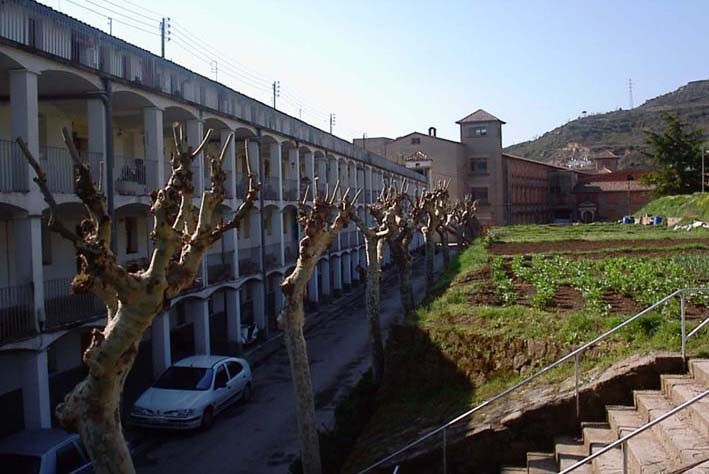

El Guixaró
El Guixaró is included in the municipality of Casserres, in spite of being closer to the core of Puig-Reig or Gironella. Following the river Llobregat Guixaró is located between the colonies of Viladomiu Nou and Cal Prat.
History
The origins of el Guixaró, were in the late nineteenth century, specifically in 1879, when Esteve Comelles Cluet, from Berga, bought some land nearby the Guixaró farmhouse in order to build a factory and cotton yarn, taking advantage of the Llobregat river water as a source of energy.
The factory was built between 1888 and 1889 and the old lock and wooden channel with a very small shunt (not present), was built in 1895. From the very beginning, it has a turbine to transform the force of the water into mechanical energy that gave impetus to the system of transformers and also the steam engine, which was used as a complementary energy source to counteract periods of drought and the erratic flow of the Llobregat River.
Mr. Comelles don’t just build a factory. It was time for industrial colonies and in Guixaró factory also was built flats and a range of services and facilities to the workers in order to they had everything necessary to live.
Another building that the owner had built, which was understood as a service to workers, was the church. Formerly, the church was next to the factory (the house of the director as well). Currently there is a small chapel in the building of the old schools.
Until thirty years ago, and since the beginning of the colonies, religion and the priest had a role in the social order and the daily life of the colony. The priest was the one who coordinated all the social and festive activities; was the watchful eye of the owner and he was spread among the workers, the message that the owner was like a father for the workers, a figure that provided protective work, food, and all kinds of services.
In 1902 Esteve Comelles, the founder of the colony, died, and El Guixaró remained in the hands of their children. In 1917 they sold the colony to Joan Prat, from Manresa, and he sold it in 1929, to Marc Viladomiu Santmartí, the owner of the closest colony, Viladomiu Nou. From that moment, the colony took a new impulse: the road was built connecting the Guixaró with Viladomiu Nou; enlarged floors of workers building the galleries (where settled toilets and sinks); inaugurated the new school (1932) and the football field, and finally in 1935 came electricity and drinking water to El Guixaró.
After the Civil War still appear new services and facilities for the people of the colony (kindergarten in 1946, the library in 1948, the theater, in 1949 and new flats in 1953). Also after the War of 1936-1939, specifically in 1942, built the new lock and the canal, which makes about 498m long and 2m depth, gradually took consolidating the electrification of the factory production system and expanded the space industry (1948-1950). These developments allowed overcome gradually, misery and difficulties of the hardest years of war.
This situation of full employment and full productive activity of the colony among the fifties and sixties allow growing up El Guixaró. This situation remained until the seventies. Thereafter, the signs of crisis and exhaustion of the textile model of industrial colonies became more and more palpable. The colony went losing population (people came to live in Gironella and Puig-Reig, mainly) and traditional services were being closing like the school or the store. Finally, the factory closed doors in the late eighties. Following the closure of the factory, to workers living in the colony were offered the opportunity to purchase their homes through home ownership. Currently, in El Guixaró live stably, forty people and the factory back to accommodate industrial activity.
Areas of interest
The church, the theater (it was built in 1949 and restored in 1998), the school (built in 1932), the sports area (has soccer field, indoor football field, pétanque area and recreation area for children), the source of Bauma (located on the road that connects El Guixaró with Viladomiu Nou) and the source of the corner.
- Town: Casserres
OFICINA DE TURISME DEL BERGUEDÀ
Carretera C16 Km 96
08600-Berga. Phone (+34) 654 125 696
Monday to Friday: 9 to 14h.
Saturday: 10 to 14 & 16 to 18h.
Sunday and holidays: 10 to 14h.
E-mail: turisme@elbergueda.cat
[Premsa]
Other

 English
English Follow us
Follow us







![[Tancar]](/plantilles/bergueda/img/tancar.png)

















